
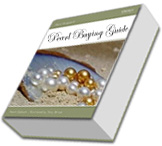
Pearl
Learning Center:
Pearls have been a source of fascination for centuries. They
have been considered the most magical and feminine of all gems and
are the only one created by a living organism. Pearls emanate a
certain warmth and glow not found in other gems, due to their unique
beginnings. Pearls are found in pearl oysters. However, the origin of
the pearl mystified humans for centuries. Many theories were put
forward regarding the origin of pearls however, it wasn't until the
turn of the twentieth century that the relationship between pearl
oysters and parasites was discovered.
Due to the
rarity and high price of natural pearls, cultured pearls feature
predominantly in jewellery stores. Side by side, it is very difficult
to tell the difference between a natural pearl and a high quality
cultured pearl with the naked eye. Pearls are composed of between 82-86%
mineral (calcium carbonate), 10-14% organic binder and 2-4% water.
They are very soft and can be chipped quite easily.
The name 'pearl' has various origins. The Teutonic derivation comes from the noun beere, meaning berry. Latin derivations are pirium, a sphere, and pirula, a pear. The Romans used the Greek word margarita, describing something of unique value, a cherished possession or a favourite child. The pearl is the birthstone for June, and also the anniversary gem for the Third and Thirtieth Wedding Anniversaries. Recognised as the emblem of modesty, chastity and purity, pearls have also come to symbolise a happy marriage.
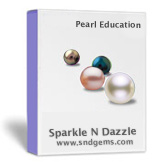
Things To
Look For:
Pearl Luster is produced when rays of light are absorbed into
and reflected back out through the nacre. Anyone buying should take
time to learn to evaluate luster. View Details.
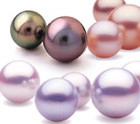
Pearl Color
includes the body color (the primary color - either light, dark), the
overtone color (a tint that appears super-imposed on the body color)
and orient. View Details.

Pearl Size:
Three things determine the size of a cultured pearl: the size of the mother-of-pearl
nucleus, the size of the oyster, and the thickness of the nacre. View
Details.

Pearl Shape in pearls is divided into three categories. Any strand of pearls should be well matched. View Details.
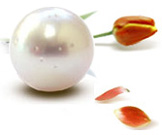
Pearl
Buying Guide:
Pearl Surface Perfection: Finer quality nacre is very smooth.
Cleaner the surface, the higher luster produced. View
Details.
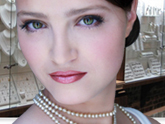
Pearl Overtone:
For white cultured pearls, there are two principal elements involved
in evaluating color: body color and overtone. The "body
color" refers to the basic color. View
Details.
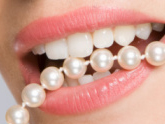
The Right Necklace:
Take a woman's age and body type into account when finding the right
necklace.

Tiffany & Co. sells silver overtones pearl strands & necklaces. We sell rose overtone pearl strand & necklace.
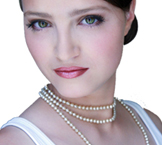
Shoppers often have questions regarding the type of pearl strands we sell and the quality of our pearls in the necklaces. To better inform the shopper we have written this guide. View Details.

Strand Necklace Glossary: Cultured pearls are real pearls that are formed naturally by a mollusk with assistance from man. A shell bead is inserted into the mollusk. View Details.

This luxury gift is a must for jewelry lovers. To shop for pearl necklace and strands Click Here.
![]()
Why
Buy From Us | References
| Site Security
| Guarantee | Return
Policy | Buyer's
Tips | FAQ | Site
Map
Product
Education | Live
Online Help | Search
Our Website | Customer
Service | Contact
Us | Payment Options
| Sales Tax
Shipping
Charges | Service
Center | Order
Tracking | Platinum
Facts | Ring Sizing
| Engraving Options
| Polishing
How
To Order | After
Sales Service | Legal
| Terms & Conditions
| Disclaimer | Product
Policies | Security
info@sndgems.com | © 2000 Sndgems Inc. | 1-800-871-1066 / 1-614-921-9024
6-6.5
mm A Necklaces | 6-6.5
mm A+ Necklaces | 6-6.5
mm AA Necklaces | 6-6.5
mm AAA Necklaces
6.5-7.0
mm A Necklaces | 6.5-7.0
mm A+ Necklaces | 6.5-7.0
mm AA Necklaces | 6.5-7.0
mm AAA Necklaces
7.0-7.5
mm A Necklaces | 7.0-7.5
mm A+ Necklaces | 7.0-7.5
mm AA Necklaces | 7.0-7.5
mm AAA Necklaces
7.5-8.0
mm A Necklaces | 7.5-8.0
mm A+ Necklaces | 7.5-8.0
mm AA Necklaces | 7.5-8.0
mm AAA Necklaces
Akoya
Pearls | Southsea
Pearls | Tahitian
Pearls Black Pearls | Cultured
Pearls | Pearl
Bracelet | Pearl Rings
Pearl
Strand | Pearl
Necklace | Japanese
Akoya Strands | Black
Tahitian Strands Necklaces | South
Sea Strands Necklaces
Pearl
Earrings | Pearl
Rings | Pearl
Bracelets | Strands
Necklaces Clasps
Diamond Necklaces | Sapphire Necklaces | Ruby Bead Strands Necklaces | Sapphire Strands | Emerald Strand Necklace